Lockheed Martin Space is one of the four major business divisions of Lockheed Martin. It has its headquarters in Littleton, Colorado, with additional sites in Valley Forge, Pennsylvania; Sunnyvale, California; Santa Cruz, California; Huntsville, Alabama; and elsewhere in the United States and United Kingdom. The division currently employs about 20,000 people, and its most notable products are commercial and military satellites, space probes, missile defense systems, NASA's Orion spacecraft, and the Space Shuttle external tank. [1]
The Lockheed Missile Systems Division was established in Van Nuys, California, in late 1953 to consolidate work on the Lockheed X-17 and X-7. The X-17 was a three-stage solid-fuel research rocket designed to test the effects of high mach atmospheric reentry. The X-17 was also used as the booster for the Operation Argus series of three high-altitude nuclear tests conducted in the South Atlantic in 1958. The Lockheed X-7 (dubbed the "Flying Stove Pipe") was an American uncrewed test bed of the 1950s for ramjet engines and missile guidance technology.
Lockheed Missiles Division moved from Van Nuys, California, to the newly constructed facility in Palo Alto, California, in 1956, then to the larger facility in Sunnyvale in 1957. The Polaris missile was the first major new program for both locations, followed later by satellite programs, thus the name change to Lockheed Missiles and Space Division.
The UGM-27 Polaris was a Submarine-launched ballistic missile (SLBM) built during the Cold War by Lockheed Missiles & Space Division in Sunnyvale, California, for the United States Navy. The Polaris program started development in 1956, with its first flight test in 1958. In 1962, the USS Ethan Allen (SSBN-608) successfully fired a Polaris A-1 missile against a test target in 1960. The SLBM has evolved through Polaris (A2), Polaris (A3), Poseidon (C3), Trident I (C4) and ongoing with today's Trident II (D5). All of these were designed and managed at the Sunnyvale facility. Together, these are known as the Navy's Fleet Ballistic Missile (FBM) Program. Lockheed Martin has been the sole provider of FBM missiles since 1956.
Lockheed Missiles & Space became prime contractor for elements of Military Satellite System (WS 117L), calling for the development of a strategic satellite system. The core element was Lockheed's Agena spacecraft, the world's first multipurpose spacecraft with boost and maneuvering engines, also acting as the 2nd stage of the launch vehicle and/or carrier vehicle for the reconnaissance system. WS-117L and Agena lead to the development of the Corona (satellite)—the nation's first photo reconnaissance satellite system, collecting both intelligence and mapping imagery from August 1960 until May 1972. Over 800,000 images were taken from space, with imaging resolution originally equaling 8 metres (26 ft 3 in), later improved to 2 metres (6 ft 7 in). The program was declassified in February 1995. Approximately 365 Agena spacecraft supported a wide variety of missions, from NASA's early interplanetary efforts; to the US Navy's SeaSat, the USAF's Corona, Midas and Samos series between January 1959 and February 1987, when the last Agena D was launched.
The Corona program led to the development of the KH-7 Gambit and KH-9 Hexagon programs. The first Gambit system, launched in 1963, was equipped with a 77 in (2,000 mm) focal length camera system. The second system, KH-8 Gambit 3, was equipped with the camera system that included a 175 in (4,400 mm) focal length camera. The system was first launched in 1966 and provided the U.S. with exquisite surveillance capabilities from space for nearly two decades. Hexagon was first launched in 1971 to improve upon Corona's capability to image broad denied areas for threats to the United States. Twelve of the 19 systems flown also carried a mapping camera to aid in U.S. military war planning. In addition, Gambit and Hexagon were launched aboard rockets built by Lockheed Martin heritage companies. Gambit 1 was launched on an Atlas launch vehicle with the orbiting Agena D upper stage and Gambit 3 was launched using a Titan IIIB booster. Hexagon was launched aboard the larger Titan IIID launch vehicle.
Lockheed achieved the first-ever hit-to-kill of an Intercontinental ballistic missile ICBM reentry vehicle in 1984 with the Homing Overlay Experiment, using the Kinetic Kill Vehicle (KKV) force of impact alone to destroy a mock warhead outside the Earth's atmosphere. The KKV was equipped with an infrared seeker, guidance electronics and a propulsion system. Once in space, the KKV could extend a folded structure similar to an umbrella skeleton of 4 m (13 ft) diameter to enhance its effective cross section. This device would destroy the Minuteman RV with a closing speed of about 20,000 ft/s (6,100 m/s) at an altitude of more than 100 mi (160 km). Further testing produced the Terminal High Altitude Area Defense (THAAD) Weapon System, the Medium Extended Air Defense System (MEADS) and the Multiple Kill Vehicle (MKV).
The Titan I was the first version of the Titan family of rockets, first developed in October 1955, when the U.S. Air Force awarded the then Martin Company in Denver, Colorado, a contract to build an Intercontinental ballistic missile (ICBM). It was the United States' first two-stage rocket and formed an integral part of their strategic deterrent force. In the early 1960s, the rocket was adapted to launch the Gemini capsule that carried two people at a time into space. Titan II succeeded in launching 12 Gemini spacecraft and has also helped to launch the Viking missions to Mars, Voyager 1 and 2 and most recently Cassini–Huygens to Saturn. It began as a backup ICBM project in case the Atlas was delayed. It was a two-stage rocket powered by RP-1 and LOX. The Titan I and Atlas ICBMs using RP-1/LOX fuel did not have a quick launch sequence. They took about 30 minutes to fuel up and fire. Most Titan rockets were derivatives of the Titan II ICBM. The Titan II ICBM had one W-53 warhead with a 9 megaton yield, making it the most powerful ICBM on-standby in the U.S. nuclear arsenal. The Titan III was a modified Titan II with optional solid rocket boosters. It was developed by the U.S. Air Force as a heavy-lift satellite launcher to be used mainly to launch U.S. Military payloads such as Defense Support Program (DSP) early-warning, intelligence (spy), and defense communications satellites. The Titan IV is a stretched Titan III with non-optional solid rocket boosters. It could be launched either with the Centaur upper stage, with the Inertial Upper Stage (IUS) or without any upper stage. It was almost exclusively used to launch U.S. military payloads, though it was also used to launch NASA's Cassini–Huygens probe to Saturn in 1997. [2]
On February 8, 2020, Lockheed announced it selected Los Angeles-based rocket-builder ABL Space to launch a mission from Scotland in two years, which the companies expect to be the first from the U.K. and first from European soil. [3]
RCA Astro-Electronics Division, a division of RCA, was formed in the late 1950s and went on to become one of the leading American manufacturers of satellites and other space systems, including the world's first weather satellite, TIROS, launched in 1960. [4] The spacecraft design and manufacturing facility was located in East Windsor, New Jersey. [5] [6]
In 1985, two members of the Astro Electronics engineering staff, Bob Cenker [7] and Gerard E. Magilton, [8] were selected to train as NASA Payload Specialists for the Space Shuttle Columbia mission designated as STS-61-C. The primary goal of the flight was to deliver a communications satellite, RCA Americom Satcom KU-1, [9] designed and built at the Astro-Electronics facility, into orbit. Cenker was selected as a member of the flight crew, and Magilton was assigned as the back-up. When Columbia launched on January 12, 1986, Bob Cenker became RCA Astro-Electronic's first astronaut. [10] [11] [12] [13] Following the destruction of Space Shuttle Challenger with the next Shuttle mission, [14] civilian Payload Specialists were excluded from flying Shuttle missions until 1990. [15] By that time, RCA had been purchased by General Electric, and RCA Astro-Electronics became part of GE. [16] [5] As a result, Cenker was the only RCA Astro-Electronics employee, and only employee in the history of the facility under all of its subsequent names, to ever fly in space.
The facility operated as GE Astro Space until it was sold to Martin Marietta in 1993. [16] Then in 1995 it became part of the newly named Lockheed Martin following the Martin Marietta merger with the Lockheed. [16] Soon after the merger, Lockheed Martin announced that the New Jersey facility would be closed. The New Jersey facility completed work on the in-process projects over the next few years, transferring the majority of work to other Lockheed Martin facilities, including the heritage-Lockheed facility in Sunnyvale, California, and a newly built facility in Newtown, Pennsylvania. The facility that began as RCA Astro Electronics closed for good in 1998. [16] [5]
Lockheed Martin Space Systems is now headquartered in Denver, but still does considerable operations from Sunnyvale. Also located near Sunnyvale is the main office of Lockheed Martin's space research and development group, the Advanced Technology Center (ATC), formerly the Lockheed Palo Alto Research Laboratory (LPARL).
On August 31, 2006, NASA selected Lockheed Martin Corp., based in Bethesda, Maryland, as the prime contractor to design, develop, and build Orion, U.S.-European spacecraft for a new generation of explorers. As of May 21, 2011, the Orion spacecraft is being developed for crewed missions to Moon and then to Mars. It will be launched by the Space Launch System.
In November 2010, Lockheed Martin Space Systems was selected by NASA for consideration for potential contract awards for heavy lift launch vehicle system concepts, and propulsion technologies.
In June 2014, the company was contracted by the United States Air Force on a fixed-price basis to build the fifth and sixth Geosynchronous Earth Orbit (GEO) satellites, known as GEO-5 and GEO-6, for the Space-Based Infrared System (SBIRS) at a cost of US$1.86 billion.
In June 2015, Lockheed Martin announced plans to expand its workforce at Cape Canaveral, Florida, in order to support the U.S. Navy's Trident II D5 Fleet Ballistic Missile program. [17]
Lockheed Martin Space comprises five Lines of Business (LOBs). Each of these is a P & L (profit and loss center) focused on a set of specific customers and related products. Each LOB is led by a vice president and general manager.
Vice President and General Manager: Kyle Griffin [18]
Customers: NASA, NOAA, international space agencies
Products: Earth observation, lunar and planetary exploration, and human spaceflight systems
Vice President and General Manager: Johnathon Caldwell
Customers: USAF, US Navy, DARPA, allied military agencies
Products: Surveillance, early warning and navigation satellites
Vice President and General Manager: Stacy Kubicek
Customers: USAF, US Navy, DARPA, allied government agencies, commercial satellite operators
Products: satellite ground systems, mission architecture, sensor processing & analysis, cyber protection
Vice President and General Manager: Sarah Hiza [20]
Customers: USN, USAF, DARPA, MDA, UK Royal Navy
Products: Missiles, hypersonic reentry vehicles, kill vehicles, battle management software, and directed energy weapons
Vice President and General Manager: Maria Demaree
Customers: undisclosed
Products: classified missions

Titan was a family of United States expendable rockets used between 1959 and 2005. The Titan I and Titan II were part of the US Air Force's intercontinental ballistic missile (ICBM) fleet until 1987. The space launch vehicle versions contributed the majority of the 368 Titan launches, including all the Project Gemini crewed flights of the mid-1960s. Titan vehicles were also used to lift US military payloads as well as civilian agency reconnaissance satellites and to send interplanetary scientific probes throughout the Solar System.

Vandenberg Space Force Base, previously Vandenberg Air Force Base, is a United States Space Force Base in Santa Barbara County, California. Established in 1941, Vandenberg Space Force Base is a space launch base, launching spacecraft from the Western Range, and also performs missile testing. The United States Space Force's Space Launch Delta 30 serves as the host delta for the base. In addition to its military space launch mission, Vandenberg Space Force Base also hosts space launches for civil and commercial space entities, such as NASA and SpaceX.

The Corona program was a series of American strategic reconnaissance satellites produced and operated by the Central Intelligence Agency (CIA) Directorate of Science & Technology with substantial assistance from the U.S. Air Force. The CORONA satellites were used for photographic surveillance of the Soviet Union (USSR), China, and other areas beginning in June 1959 and ending in May 1972.
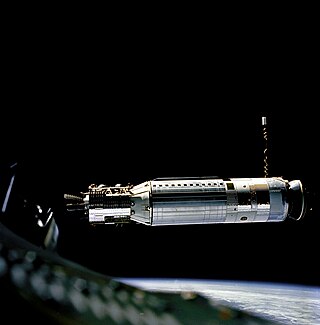
The RM-81 Agena was an American rocket upper stage and satellite bus which was developed by Lockheed Corporation initially for the canceled WS-117L reconnaissance satellite program. Following the split-up of WS-117L into SAMOS and Corona for image intelligence, and MIDAS for early warning, the Agena was later used as an upper stage, and an integrated component, for several programs, including Corona reconnaissance satellites and the Agena Target Vehicle used to demonstrate rendezvous and docking during Project Gemini. It was used as an upper stage on the Atlas, Thor, Thorad and Titan IIIB rockets, and considered for others including the Space Shuttle and Atlas V. A total of 365 Agena rockets were launched between February 28, 1959 and February 1987. Only 33 Agenas carried NASA payloads and the vast majority were for DoD programs.

Cape Canaveral Space Force Station (CCSFS) is an installation of the United States Space Force's Space Launch Delta 45, located on Cape Canaveral in Brevard County, Florida.

Robert Joseph "Bob" Cenker is an American aerospace and electrical engineer, aerospace systems consultant, and former astronaut. Cenker worked for 18 years at RCA Astro-Electronics, and its successor company GE Astro Space, on a variety of spacecraft projects. He spent most of his career working on commercial communications satellites, including the Satcom, Spacenet and GStar programs.

BYEMAN codenamed LANYARD, the KH-6 was the unsuccessful first attempt to develop and deploy a very high-resolution optical reconnaissance satellite by the United States National Reconnaissance Office. Launches and launch attempts spanned the period from March to July 1963. The project was quickly put together to get imagery of a site near Leningrad suspected of having anti-ballistic missiles. The satellite carried Itek's "E-5" camera developed for the SAMOS program, which had been cancelled. The camera had a focal length of 1.67 m and could discern objects on the ground 1.8 m in size. The ground swath of the camera was 14 km × 74 km. The satellite weighed 1,500 kg (3,300 lb), and had a single re-entry vehicle in which exposed film was returned to earth for a mid-air aircraft recovery. The KH-6 was manufactured by Lockheed Martin and launched from Vandenberg Air Force Base on Thor-Agena D launch vehicles.

BYEMAN codenamed GAMBIT, the KH-7 was a reconnaissance satellite used by the United States from July 1963 to June 1967. Like the older CORONA system, it acquired imagery intelligence by taking photographs and returning the undeveloped film to earth. It achieved a typical ground-resolution of 0.61 m to 0.91 m. Though most of the imagery from the KH-7 satellites was declassified in 2002, details of the satellite program remained classified until 2011.

Titan IIIB was the collective name for a number of derivatives of the Titan II ICBM and Titan III launch vehicle, modified by the addition of an Agena upper stage. It consisted of four separate rockets. The Titan 23B was a basic Titan II with an Agena upper stage, and the Titan 24B was the same concept, but using the slightly enlarged Titan IIIM rocket as the base. The Titan 33B was a Titan 23B with the Agena enclosed in an enlarged fairing, in order to allow larger payloads to be launched. The final member of the Titan IIIB family was the Titan 34B which was a Titan 24B with the larger fairing used on the Titan 33B.

Space Launch Complex 3 (SLC-3) is a launch site at Vandenberg Space Force Base that consists of two separate launch pads. SLC-3E (East) is currently used by the Atlas V launch vehicle, while SLC-3W (West) has been demolished.
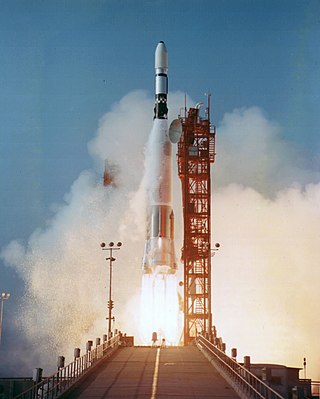
The Atlas-Agena was an American expendable launch system derived from the SM-65 Atlas missile. It was a member of the Atlas family of rockets, and was launched 109 times between 1960 and 1978. It was used to launch the first five Mariner uncrewed probes to the planets Venus and Mars, and the Ranger and Lunar Orbiter uncrewed probes to the Moon. The upper stage was also used as an uncrewed orbital target vehicle for the Gemini crewed spacecraft to practice rendezvous and docking. However, the launch vehicle family was originally developed for the Air Force and most of its launches were classified DoD payloads.

Atlas is a family of US missiles and space launch vehicles that originated with the SM-65 Atlas. The Atlas intercontinental ballistic missile (ICBM) program was initiated in the late 1950s under the Convair Division of General Dynamics. Atlas was a liquid propellant rocket burning RP-1 kerosene fuel with liquid oxygen in three engines configured in an unusual "stage-and-a-half" or "parallel staging" design: two outboard booster engines were jettisoned along with supporting structures during ascent, while the center sustainer engine, propellant tanks and other structural elements remained connected through propellant depletion and engine shutdown.

Space Systems Command (SSC) is the United States Space Force's space development, acquisition, launch, and logistics field command. It is headquartered at Los Angeles Air Force Base, California and manages the United States' space launch ranges.

Thor was a US space launch vehicle derived from the PGM-17 Thor intermediate-range ballistic missile. The Thor rocket was the first member of the Delta rocket family of space launch vehicles. The last launch of a direct derivative of the Thor missile occurred in 2018 as the first stage of the final Delta II.
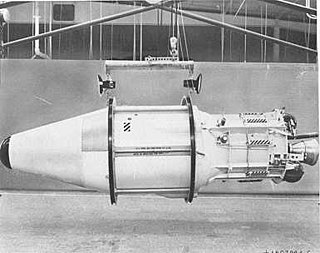
Discoverer 1 was the first of a series of satellites which were part of the CORONA reconnaissance satellite program. It was launched on a Thor-Agena A rocket on 28 February 1959 at 21:49:16 GMT from Vandenberg Air Force Base in California. It was a prototype of the KH-1 satellite, but did not contain either a camera or a film capsule. It was the first satellite launched toward the South Pole in an attempt to achieve a polar orbit, but was unsuccessful. A CIA report, later declassified, concluded that "Today, most people believe the Discoverer 1 landed somewhere near the South Pole".
The Atlas SLV-3, or SLV-3 Atlas was an American expendable launch system derived from the SM-65 Atlas / SM-65D Atlas missile. It was a member of the Atlas family of rockets.

The 6555th Aerospace Test Group is an inactive United States Air Force unit. It was last assigned to the Eastern Space and Missile Center and stationed at Patrick Air Force Base, Florida. It was inactivated on 1 October 1990.

The ascent propulsion system (APS) or lunar module ascent engine (LMAE) is a fixed-thrust hypergolic rocket engine developed by Bell Aerosystems for use in the Apollo Lunar Module ascent stage. It used Aerozine 50 fuel, and N
2O
4 oxidizer. Rocketdyne provided the injector system, at the request of NASA, when Bell could not solve combustion instability problems.
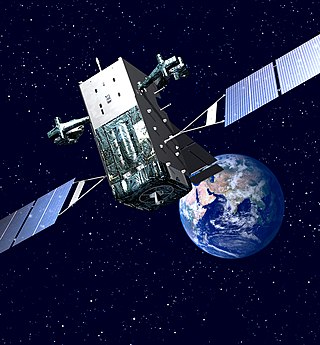
USA-282, also known as SBIRS GEO-4, is a United States military satellite and part of the Space-Based Infrared System.
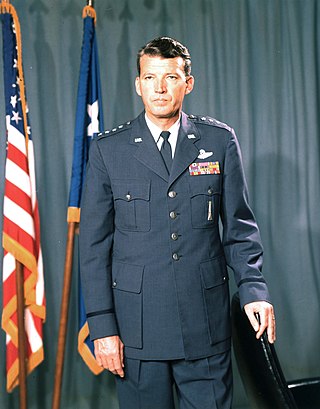
While the United States Space Force gained its independence on 20 December 2019, the history of the United States Space Force can be traced back to the beginnings of the military space program following the conclusion of the Second World War in 1945. Early military space development was begun within the United States Army Air Forces by General Henry H. Arnold, who identified space as a crucial military arena decades before the first spaceflight. Gaining its independence from the Army on 18 September 1947, the United States Air Force began development of military space and ballistic missile programs, while also competing with the United States Army and United States Navy for the space mission.
After GE acquired RCA in 1986, it combined AED with the Spacecraft Operations of its Space Systems Division to form the GE Astro Space Division. The entire division was sold to Martin Marietta in 1993, which in turn merged with Lockheed to form Lockheed Martin in 1995. Soon after the merger, Lockheed Martin announced that they would be closing the former AED facility. In 1998, forty years after its establishment, the RCA Space Center shut down for good.